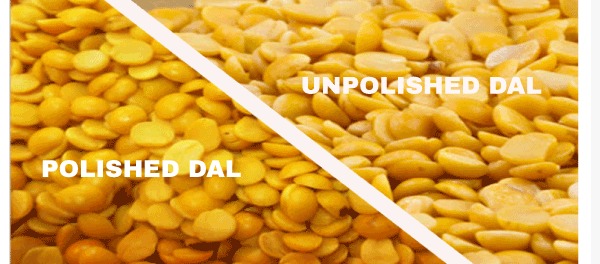Difference between Polished and Unpolished dal
Dal is one of the main components of the Indian diet. There are many types of dal that we eat, for example, chana dal, mung dal, masoor dal, urad dal. People like the dish made from dal like dal makhni, dal cutlets, dal fry, dal halwa, dal vada, etc. Dal is also considered a healthy food as it is a rich source of proteins.
Dal is a low-calorie food. There are 56 grams calories in 50 grams of cooked dal. Dal also contains fats and carbohydrates. In 50 grams of cooked dal, there are 4.5 grams of proteins and 0.2-gram fats and 10-11 grams carbohydrates. Furthermore, folic acid present in dal is goods for pregnant women and the nutritional value of dal can be increased by sprouting it.
Dal that we eat can be polished or unpolished, let us see what does it mean and how polished dal is different from an unpolished dal.

Unpolished dal
The dal which is not processed to make it shinier and packed in the most possible raw form is called unpolished dal. Unpolished Dal is high in fibre. Soluble and insoluble fibre humans get from dal. Micronutrients like potassium, magnesium, iron, zinc, thiamine are high in unpolished dal.
Unpolished Dal can be stored for 5 to 6 months. Always store unpolished dal in a cool and dry place. The taste of this dal is good. This dal requires less time to cooks. This dal is healthier.
The price of this dal is high. Because they contain more fibre and are full of all nutrition. This dal is the choice of vegan people. This is the reason behind the high cost of unpolished dal.
Polished dal
The raw reaped dal that is processed to give it a shinier texture is known as polished dal. Polished Dal is low in fibre as the fibre content is reduced due to polishing. The micronutrients like potassium, magnesium, iron, zinc, etc., are also lost by polishing dal. Just to increase the aesthetic value of dal, the dal is polished. The dal looks good after polishing. The self-life of dal increases by polishing the dal. Polished Dal can be stored for 9 to 10 months.
By polishing the dal, the particles of chemical pesticides are also removed. This dal requires more time to cook. This dal is less healthy. It is uniform, shiny and bright in color. Actually, no layers are added to the polished dal. In fact, its outer layer is removed in the process of polishing.
The price of this dal is low. The reason behind that is polished dal are sold more. Another reason for low cost is many times they sold spoiled unpolished dal by polishing it.
What is used to polish the dal?
Oil, leather, water is used to polish the dal. If oil is used to polish the dal, then unnecessary calories are added to the dal. Dal is very important for vegans and vegetarians, but if the leather has been used to polish the dal, then vegans cannot eat that dal. If the dal is to be polished with water, then that water should be clean. It should come from a reliable source so that it may not affect the health of humans.
Why is dal polished?
- To reduce chemical pesticides from dal.
- To make dal look nice, shiny, bright and dark in color.
- To store dal for a long time. As its outer layer is removed, so there will be less moisture in it.
- To sell the old dal in the market, it is polished so that it looks like a new dal.
Difference between Polished dal and Unpolished dal:
| Polished Dal | Unpolished Dal |
|---|---|
| It is processed to make its texture shinier. | Its texture is not improved through processing. It is sold in the most possible raw form. |
| Vegans cannot eat that dal. | Vegans can eat that dal. |
| It contains less fiber. | It contains more fiber. |
| It is less healthy than unpolished dal. | It is healthier than polished dal. |
| Its outer cover is removed in the process of polishing. | Outer covered of dal is present. |
| The particles of chemical pesticides are reduced because of polishing. | Some quantity of chemical pesticides is present in dal. |
| Dal is looking shiny. | Dal is not looking shiny. |
| Dal is bright in color. | Dal is dull in color. |
| The price of dal is low. | The price of dal is high compared to polished dal. |
| Dal can be stored for 9 to 10 months. | Dal can be stored for 5 to 6 months. |
| Micronutrients are lost due to polishing. | Micronutrients are present in this dal. |
